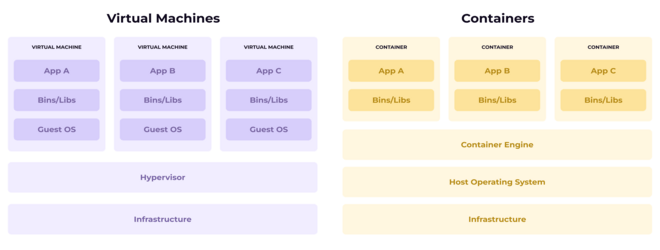Difference between Container and Virtual Machine

Containers and Virtual Machines (VM) are two technologies that are used to run software and applications in separate environments. However, there are some important differences between the two. Below is an analysis of the differences between these two technologies.
(Definition)
Container :A container is a lightweight mechanism that packages together an application and all its dependencies (libraries, files, etc.). It runs on a shared kernel.
Virtual machine :
A virtual machine is a fully virtualized environment that acts like a physical machine. It creates a virtualized environment with a complete copy of an operating system (OS).
(Architecture)
Container : Containers use a shared kernel for multiple applications. It uses a single copy of the operating system and all containers run on the same OS.
Virtual machine :
A VM contains a copy of a complete operating system, creating a completely separate hardware and software environment. It uses hypervisor technology.
(Resource utilization)
Container : Containers are relatively lightweight and fast, as they use a shared kernel rather than a full copy of the OS. They typically use less RAM and CPU.
Virtual machine :
VMs are relatively heavy and slow, as they run a copy of the entire operating system. They use more RAM and CPU, which often makes the physical hardware heavier.
(Performance)
Container : Container performance is often better because it shares computer resources and loads quickly, allowing for faster development and deployment.
Virtual machine :
The VM's performance may be slower because it carries the entire operating system. It may take some time to start and the loading time may be longer.
(Security)
Container : Container security is relatively low. If a security problem occurs in one container, it can spread to other containers.
Virtual machine :
VMs are strong in terms of security. The OS running in a VM is completely isolated, which reduces security risks.
Summary
|
Subject |
Container |
Virtual machine |
|
Definition |
A lightweight packaging technology |
Fully virtualized environment |
|
Architecture |
Shared kernel |
Copy of the entire operating system |
|
Resource usage |
Relatively low RAM and CPU |
More RAM and CPU used |
|
Performance |
Fast and light |
Slow and heavy |
|
Security |
Low security |
High security |
Both containers and virtual machines come with their own advantages and limitations. Containers are typically lightweight, fast, and easy to manage, while virtual machines provide security and complete isolation. It is important to choose the right technology for your needs.







